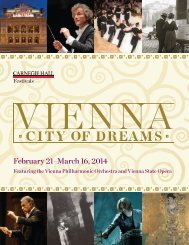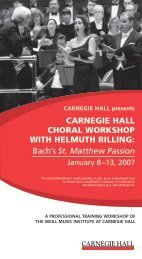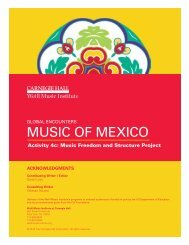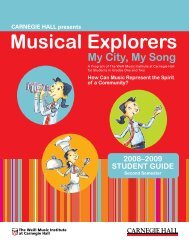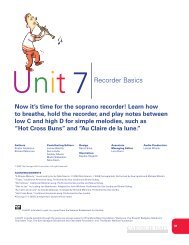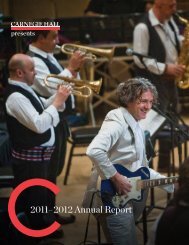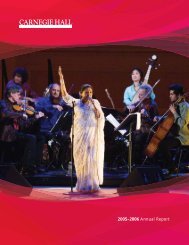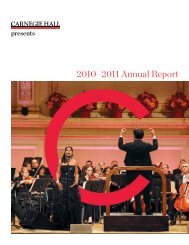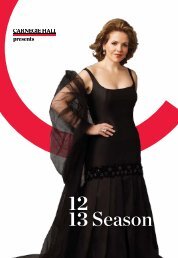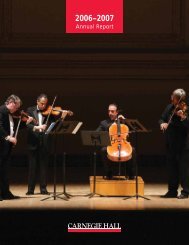roMani MusiC of turKeY - Carnegie Hall
roMani MusiC of turKeY - Carnegie Hall
roMani MusiC of turKeY - Carnegie Hall
You also want an ePaper? Increase the reach of your titles
YUMPU automatically turns print PDFs into web optimized ePapers that Google loves.
PRoJeCT eXaMPle: MUsIC<br />
Your students can choose from three different options for this project, depending on their areas <strong>of</strong> expertise.<br />
oPTIon 1: PlaYInG RoManI MeloDIes<br />
aIM: How does performance <strong>of</strong> Romani melodies affect our understanding <strong>of</strong> Romani culture?<br />
sUMMaRY: Students rehearse and perform a traditional Romani melody.<br />
TIMe ReQUIReD: 60–90 minutes<br />
Have students play or sing “Kasap Havasi” (Tracks 12 and 13).<br />
Note: We have included sheet music (in several different keys) on pp. 39–42. Experiment with these different<br />
keys until you settle on a key that all <strong>of</strong> your students are comfortable with.<br />
oPTIon 2: fReeDoM anD sTRUCTURe: IMPRoVIsaTIon<br />
aIM: How does our featured artist make the most <strong>of</strong> freedom and structure in musical improvisations?<br />
sUMMaRY: Students connect their own lives to musical improvisation.<br />
TIMe ReQUIReD: 60–90 minutes<br />
Lead your students in the Teaching Artist visit 1 lesson.<br />
oPTIon 3: “s¸ InanaRI”—MeloDY anD oRnaMenT MUsIC lessons<br />
aIM: How does Selim Sesler create Romani-style melodic ornamentation?<br />
sUMMaRY: Students establish the idea <strong>of</strong> ornament using their prior knowledge, establish a physical<br />
familiarity with the melody <strong>of</strong> the Turkish song “S¸ inanari,” and discover the musical ornaments that typify<br />
Romani clarinet playing.<br />
TIMe ReQUIReD: 60–90 minutes<br />
PaRT 1: enTRY PoInT—PeRsonal oRnaMenTs<br />
Define personal ornaments (for example: objects that beautify the body, or function as amulets or “love letters” in<br />
courtship; expressions <strong>of</strong> individual and group identity; markers <strong>of</strong> age, class, gender, wealth, or social status).<br />
Have students, in pairs, create outlined line drawings <strong>of</strong> the human figure.<br />
The Weill Music Institute<br />
Have at students <strong>Carnegie</strong> add <strong>Hall</strong> their own drawn personal ornaments with colored markers. Post the students’ work on the wall.<br />
ask students:<br />
“How do you know what kinds <strong>of</strong> personal ornaments to add?”<br />
The “What Weill is Music too much?” Institute<br />
at <strong>Carnegie</strong> <strong>Hall</strong><br />
“What is not enough?”<br />
“What style or kind <strong>of</strong> ornament do you prefer or dislike?”<br />
“Where do you think that preference originated?”<br />
The Weill Music Institute<br />
at <strong>Carnegie</strong> “What effect <strong>Hall</strong> does someone’s personal ornaments have on your perception <strong>of</strong> that person?”<br />
32<br />
The Weill Music Institute<br />
at <strong>Carnegie</strong> <strong>Hall</strong> Citi Global Encounters




